
Rena humilis, known commonly as the western blind snake, the western slender blind snake, or the western threadsnake, is a species of snake in the family Leptotyphlopidae. The species is endemic to the southwestern United States and northern Mexico. Six subspecies are currently recognized, including the nominate subspecies described here.
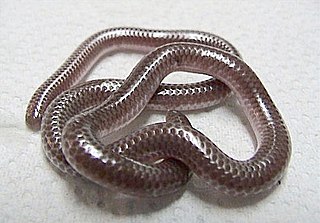
Rena dulcis, also known commonly as the Texas blind snake, the Texas slender blind snake, or the Texas threadsnake, is a species of snake in the family Leptotyphlopidae. The species is endemic to the Southwestern United States and adjacent northern Mexico. Three subspecies are currently recognized, including the nominate subspecies described here.

The gray-banded kingsnake, sometimes referred to as the alterna or the Davis Mountain king snake, is a species of nonvenomous snake in the family Colubridae. The species is endemic to the southwestern United States and adjacent Mexico. Some sources list two distinct subspecies of Lampropeltis alterna, as L. a. alterna and L. a. blairi differentiated by patterning and locale, but research has shown them to be color morphs of the same species.

Tropidoclonion is a genus of snake in the subfamily Natricinae of the family Colubridae. The genus is monotypic, containing the sole species Tropidoclonion lineatum, commonly known as the lined snake. The species is endemic to North America.
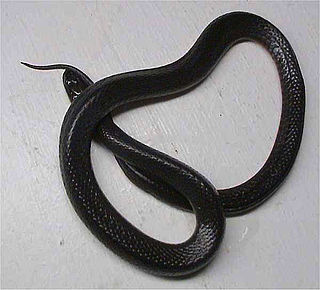
The black swamp snake is a species of snake in the subfamily Natricinae of the family Colubridae. The species is endemic to the southeastern United States. There are three subspecies, including the nominotypical subspecies.

The long-nosed snake is a species of nonvenomous snake in the family Colubridae. The species is endemic to North America. It has two recognized subspecies. The other species in the genus were previously considered subspecies.

Salvadora is a genus of colubrid snakes commonly called patchnose snakes or patch-nosed snakes, which are endemic to the western United States and Mexico. They are characterized by having a distinctive scale on the tip of the snout.

Nerodia rhombifer, commonly known as the diamondback water snake, is a species of nonvenomous natricine colubrid endemic to the central United States and northern Mexico. There are three recognized subspecies of N. rhombifer, including the nominotypical subspecies.

Hypsiglena jani, commonly known as the Texas night snake or the Chihuahuan night snake, is a small species of mildly venomous snake in the family Colubridae. The species is native to the southwestern United States and adjacent northeastern Mexico.

Ficimia streckeri, also commonly known as the Mexican hooknose snake, the Tamaulipan hooknose snake, and the Texas hook-nosed snake, is a small species of snake in the family Colubridae. The species is native to northeastern Mexico and adjacent southern Texas.

The Texas scarlet snake is a species of nonvenomous snake in the family Colubridae. The species is endemic to the South Central United States. It was previously considered a subspecies of Cemophora coccinea.

The Texas lined snake is a subspecies of nonvenomous snake in the subfamily Natricinae of the family Colubridae. The subspecies is endemic to the United States.

The western ground snake is a species of small, harmless colubrid snake. The species is endemic to North America. Its patterning and coloration can vary widely, even within the same geographic region. Another common name is miter snake referring to the head marking which suggests a bishop's miter; the synonym "episcopus " is a similar allusion.

Rhinocheilus is a genus of snakes, commonly called the long-nosed snakes, in the family Colubridae. The genus is native to the western United States and Mexico.
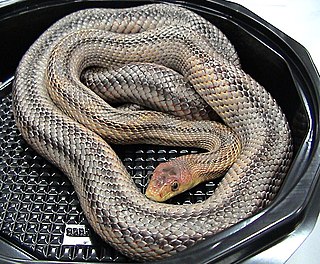
Pantherophis bairdi is a species of harmless snake in the family Colubridae. The species is native to the southwestern United States and adjacent northeastern Mexico. No subspecies are recognized as being valid.
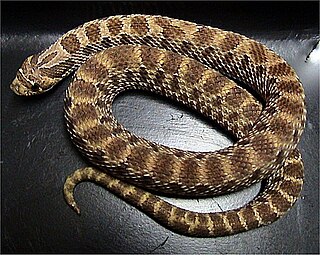
The western hognose snake is a species of snake in the family Colubridae. The species is endemic to North America. There are three subspecies that are recognized as being valid, including the nominotypical subspecies.

The smooth earth snake is a species of nonvenomous natricine colubrid snake native to the eastern half of the United States.

The crayfish snake, also known commonly as the glossy crayfish snake, the glossy swampsnake, the glossy water snake, and the striped water snake, is a species of semiaquatic snake in the subfamily Natricinae of the family Colubridae. The species is endemic to the southeastern United States, and preys mainly on crayfish.

The long-nosed leopard lizard is a species of relatively large North American lizard in the family Crotaphytidae. Gambelia wislizenii ranges in snout-to-vent length (SVL) from 8.3 to 14.6 cm. It has a large head, a long nose, and a long round tail that can be longer than its body. It is closely related to the blunt-nosed leopard lizard, which closely resembles the long-nosed leopard lizard in body proportions, but has a conspicuously blunt snout. The species G. wislizenii, once considered part of the genus Crotaphytus, is under moderate pressure because of habitat destruction but is categorized as "least concern".
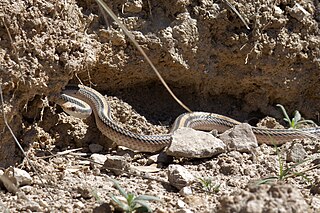
Salvadora hexalepis, the western patch-nosed snake, is a species of non-venomous colubrid snake, which is endemic to the southwestern United States and northern Mexico.



















